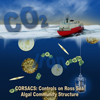
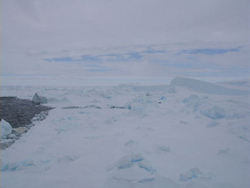
Bay
of Whales
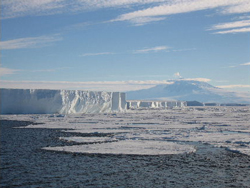
Ross
Ice Shelf
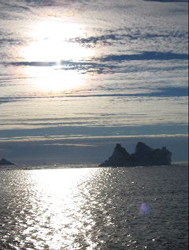
Bay
of Whales
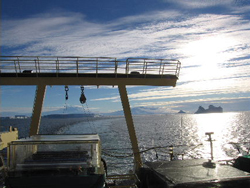
Bay
of Whales
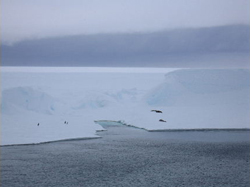
Bay
of Whales (Mak Saito)
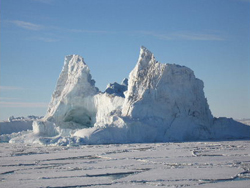
Bay
of Whales

Bay
of Whales (Abigail Noble)
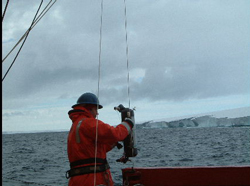
Pete
Sedwick conducting a trace metal sampling cast in the Bay of Whales. (Mak Saito)
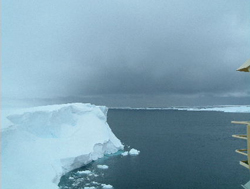
Bay
of Whales (Mak Saito)
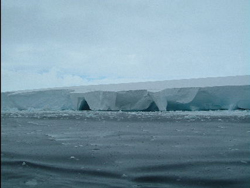
Bay
of Whales (Mak Saito)
| CORSACS: Controls on Ross Sea Algal
Community Structure
2005: A Research Cruise to the Ross Sea to Study What Controls
the Phytoplankton DynamicsLife at Sea These
are updates from Brian, who gives us his perspective as someone who hasn't been
to Antarctica, or even to sea before! A
New Record! Further South than Ever Before (that we know of)!
January 14, 2006
- The Bay of Whales
January 14, 2006 was an extraordinary day at
sea. Our research took us to the Ross Ice Shelf at a place called The Bay of Whales.
The ice shelf is a glacier, a river of ice roughly the size of France, which flows
very, very slowly from the continent to the sea. The shelf forms a cliff
at the sea edge, about thirty feet high and hundreds of miles long. The water
is deep right to the face of the shelf and the shelf is so sheer that the scientists
were able to collect algae samples by simply reaching out from the ship with nets
and other implements. As the sea beats against the shelf, caverns are cut. As
large pieces of ice part from the shelf, or “calve off”, angles appear.
The very old, dense ice is a deep blue.The newer, lighter ice is brilliant white.
The sun comes at a strange angle due to our position on the Earth and the ice
reflects its light like a diamond does. This enormous ice river floats on the
sea as it leaves the Antarctic continent. Roosevelt Island, some three miles south
of the ice edge, temporarily splits the glacier in two, forming the cleft that
is The Bay of Whales. The Bay of Whales is the southernmost navigable point
on the Earth. Recently, a combination of ice movement, melting and calving off
of ice made the cleft even deeper. We sailed in as far as we could go, establishing
a new record. At -078 40.891 latitude, -164 11.650 longitude, we had sailed further
south than anyone in recorded history ever has. We left The Bay of Whales,
past the fantastic ice formations, and into the deep water. Anyone who has spent
time looking at clouds and seeing dragons or sailboats in their shapes could pass
time similarly with the floating ice we passed. My friend Maeve saw one that looked
like three men in a hot tub. Every day at sea is not like today. In fact,
not one of my days has ever been like today. Most of our time at sea has been
hard work and the inside of a laboratory. But with hard work comes privilege,
and today was truly a privilege. Comment from website viewer: Hello!
Could
not believe my eyes when I read today of your southernmost achievement! I suppose
that you know that on 28 January 2005 we achieved 78deg 40min 0515 S at Bay of
Whales, on board Spirit of Enderby, having beaten the 2001 record of Klebnikov,
at 78 37 ??, so you've beaten us! Boohoo! Just LOVED your website and am absolutely
fascinated with what you're doing. Is receding ice-coast line a sign of global
warming? So many ask me this question when I show my Powerpoint presentation to
fellow Zimbabweans, that I would love to know what you all think? Enjoy your research!
Lynne Taylor Harare. ------------------------
Holidays
at Sea
The best place to be during the holidays is with your family.The
next best place to be is wherever you are.Although we on the Nathaniel B. Palmer
were not able to be with our families this holiday season, we had a memorable,
unique and very special experience together.
Each laboratory in the Palmer
was decorated for Christmas just as if we had been at home.The Lab I work in was
decorated with a table top tree, blinking lights, and red ball ornaments.We sang
Christmas carols, exchanged small gifts and exchanged stories about how Christmas
is celebrated among the various faiths and nations represented aboard the Palmer.
We ate a big Christmas dinner and had the whole day off from science.Most importantly
we were able to rest and also to reflect on the value of having a family to miss
and a home to return to. New Year’s Eve was a truly amazing experience.As
we were close to the “fast” ice at the conclusion of our experiments
for the day, we decided to spend New Year’s Eve off the ship.“Fast”
ice is thick, semi-permanent ice which will support the weight of many people.The
Palmer broke into the fast ice as far as it could, then backed up and rammed even
further just to be sure the ice was really thick and safe.The Captain sent out
an advance party to scout the ice and to mark the boundaries which we were not
to venture beyond.After these precautions had been made we were allowed to leave
the ship. Directly in front of the ship, Mt. Erebus, an active volcano,
smoked in the distance.In every other direction, as far as we could see, there
was nothing but brilliant white ice.It could have been a scene on another planet.In
the area behind the ship where the ice had been broken, Minke Whales would occasionally
surface, blowing their spouts and taking in fresh air.Then the penguins discovered
us. Penguins are very curious and have no natural enemies on land.They
were completely unafraid of us and soon joined our New Year’s party.People
working in or visiting Antarctica are bound by a treaty between participating
nations which prohibits interference with the natural activities of Antarctic
wildlife.In short, we were instructed to do nothing which would modify the behavior
of the penguins.We did not chase, tease, touch or try to lure the penguins to
us.I got the impression that the penguins were teasing us. They seemed
to love to have their pictures taken and appeared to pose when a lens was turned
their way.When a group of penguins had finished with us they would lie on their
bellies and “swim” away on the ice at a surprising speed.My favorite
image of the penguins is the way they would pop out of the water after swimming
in the open space behind the ship, land on their feet and waddle away.Both holidays
at sea were unforgettable experiences.I guess if we couldn’t be with our
families this holiday season the next best place was pretty good. ------------------------
Work
Schedules December 29, 2005: Time
is as valuable on the Nathaniel B. Palmer as is space. Scientists may plan years
ahead for a field event such as the one we are currently on. Those same scientists
may study the data collected on this field event for years afterward. Some idle
time is inevitable for some of the scientists, as we traverse from one location
to another, and a certain amount of down time is necessary as we rest, but generally
idle time is wasted time. Right out of port my cabin mate and I were set to collecting
"underway" samples. Every hour, around the clock, we collect between
three and five liters of seawater from a depth of five meters. A log is maintained
as to latitude, longitude, date, time, temperature, salinity and fluorescence.
Those samples are then filtered to separate particulate from the liquid. The liquid
is sent back to the sea and the particulate is preserved on the filters. The filters
may be frozen for later use, or analyzed immediately. The period of time
one is responsible to be on duty while at sea is called a "watch". My
watch is noon to midnight, every day. My cabin mate's watch is midnight to noon,
every day. We are seldom, if ever, in our cabin at the same time. Similar situations
exist all over the ship. Cabin space has proved to be ample. The people who designed
the ship did so knowing how scientists behave at sea and made the very wise decision
to dedicate as much space as possible to laboratories. Besides, after spending
twelve hours on my feet, with the exception of meals, I believe I could fall asleep
in a closet. Mealtimes are a welcome break during one's watch. But with
half the ship starting their day as the other half finishes, mealtime on a ship
like the Nathaniel B. Palmer is a unique experience. ------------------------
Christmas
at Sea
My First Christmas at Sea
Carol J. Pollard
12/25/2005
This
Christmas has been like no other I have ever experienced. I woke up to the bright
shining light coming through the port hole window. Wow, what a blinding brightness
as the sun reflected off the ice, the snow and the water. It was bright white
an bright blue. Our group gathered to start the day off right. We exchanged presents
and laughter and holiday wishes. I was the lucky one. I got flashing reindeer's
antlers to be worn all day. More people came from their rooms dressed in Santa
Claus hats, twinkling lights and smiling faces. Merry Christmas cheer was spread
with each greeting and my reindeer antlers got a nod of approval. Lunch came soon
and what a feast. Afterwards, just like home, a nap was due. But the best was
yet to come. Later, I put on my wool socks, boots, wool scarf, leather insulated
gloves and bright orange parka and made my way to the bow of the boat. What a
magnificent site, the endless ice, crushed and melded into figures you could pick
out, and the water so blue. It was snowing. To top off the day I saw my first
seal in the wild as well as three frolicking penguins. They played and slid on
their bellies on the ice. They were so silly and soon they were out of site. Yes,
this has been a joyful and magnificent day, one probably never to be repeated,
filled with jolly good cheer and a satisfying peacefulness at sea. ------------------------
Living
on a Ship: Cabins
When Scientists prepare to conduct experiments
at sea they have to move a great deal of equipment to the ship. That means a lot
of time is spent at the ship before it sails, and so one of the first experiences
of life at sea takes place before the ship goes to sea: the scientists move into
their new bedrooms or "cabins". Space on a ship is scarce. The rooms
are very small and they are shared by two. The rooms consist of one desk, one
chair, a bathroom, a window or porthole, with cabinets for clothing and personal
items attached to the wall on either side of the porthole. Bunk beds occupy the
wall opposite the desk. No more than three feet of free space separates the desk
wall from the bunk wall. Scientists come in all shapes and sizes. These
bunks were not built with that diversity in mind. The trick is getting in the
bunks. Once you are in you are quite comfortable as long as you don't want to
sit up. Someone larger than me may disagree... Scientists are also issued clothing
suited for extreme cold weather before leaving for Antarctica. This clothing is
very bulky and eats up a lot of cabin space. As my room mate and I entered our
cabin with our sea bags we didn't think it could possibly all fit. But
it did fit. A clever and efficient design utilized with cooperation and a little
ingenuity on the part of the room inhabitants had our cabin "shipshape"
in no time. We realized that we needed to be especially neat, organized and respectful
of the other's space. However neatness, organization and respect would not make
the cabin any bigger. We just couldn't stay out of each others way. We soon found
out we wouldn't have to. ------------------------
Imagine
life aboard a ship like the Nathaniel B. Palmer December 22,
2005; 177 and 61 44': To imagine life aboard a ship like the Nathaniel
B. Palmer, imagine that you live at your school, attend classes at least twelve
consecutive hours each day and find it impossible to safely leave the school.
Now imagine that the floor is constantly moving under you. That may seem like
a bad dream to you, but to the scientists who are living under those very conditions
it is a dream come true. In order to study the ocean around Antarctica these
men and women would endure a great deal, because that is their vocation and their
passion. The Captain and crew of the Nathaniel B. Palmer have a vocation and a
passion too. They mean to provide as much safety, support and comfort as is possible
under extraordinary conditions. The result of this cooperative effort provides
for some interesting descriptions of life aboard the Nathaniel B. Palmer. This
space will be updated, from time to time, with those descriptions. The topics
will include such events as mealtime, bedtime, play time and Christmastime. We
hope you respond with your thoughts. Not only are we interested in how you feel
about our experiences, but we're getting a little tired of listening to each other!
------------------------ Chief
Scientist's Log Technology and
Instrumentation Questions from
Visitors and Answers from Scientist Aboard the Research Vessel Palmer |

